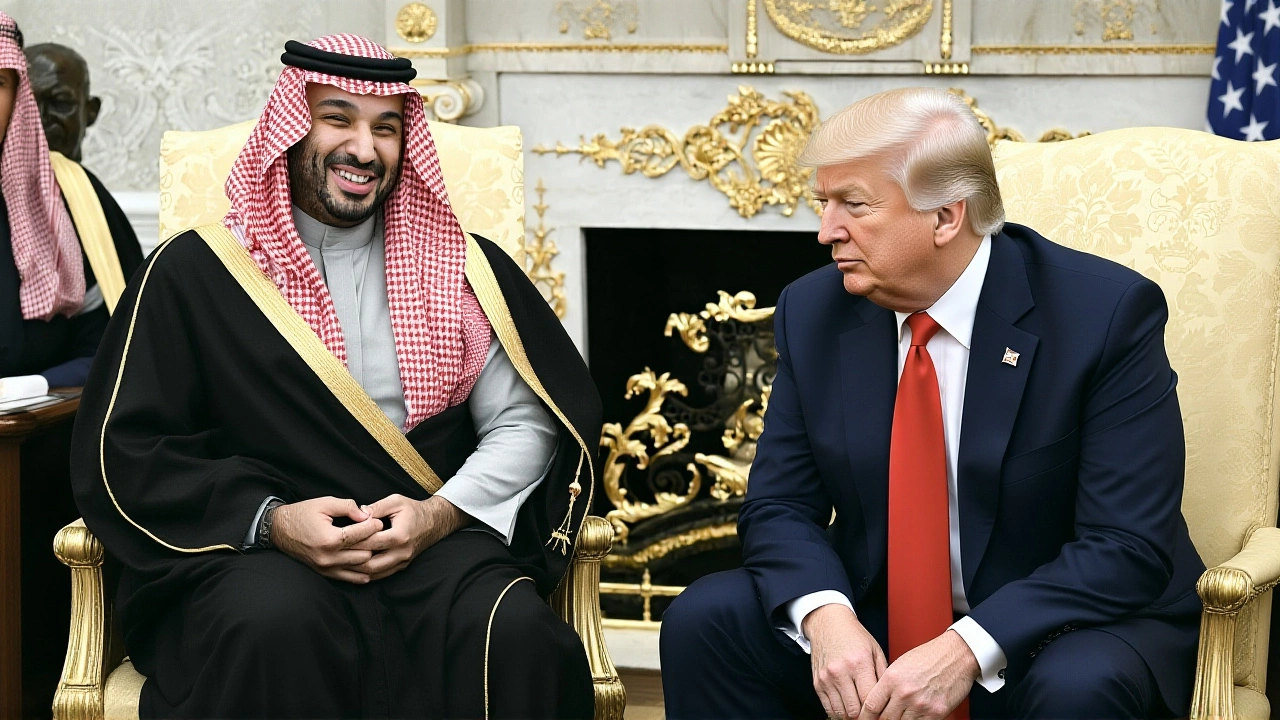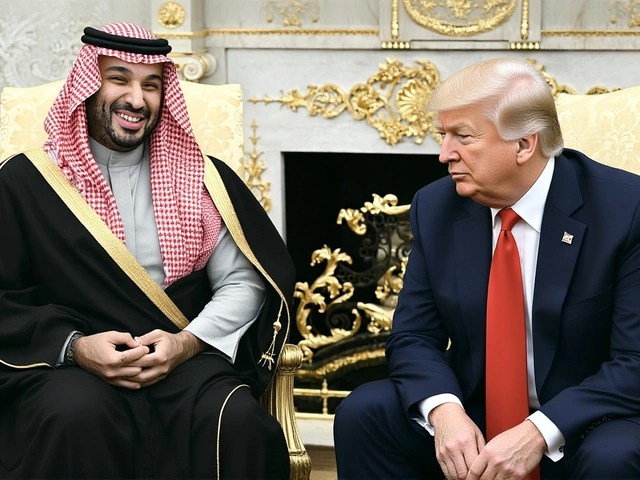
When Mohammed bin Salman Al Saud corrected Donald J. Trump in the Oval Office on November 18, 2025, it wasn’t just a polite interruption—it was a seismic shift in global economics. The Crown Prince of Saudi Arabia had just unveiled a nearly $1 trillion investment commitment into the United States, blowing past the $600 billion figure Trump had publicly cited. The moment, captured in real time by White House aides, signaled more than a numbers correction. It marked the beginning of what officials are calling the largest foreign investment pledge in American history.
A Historic Economic Pivot
The $1 trillion commitment, detailed in the White House Fact Sheet dated November 2025, isn’t a vague promise. It’s a meticulously mapped plan. Capital from the Saudi Public Investment Fund will flow into U.S. infrastructure, artificial intelligence labs, semiconductor research hubs, and next-generation energy projects—both fossil fuel and renewable. The scale is staggering: over 66% larger than the $600 billion pledged during Trump’s May 2025 trip to Riyadh. This isn’t just about money. It’s about alignment. After years of Saudi Arabia deepening ties with Beijing amid U.S. energy policy shifts, the Crown Prince has now chosen Washington as the anchor for his Vision 2030 ambitions."There are no limits," Mohammed bin Salman Al Saud told reporters after the meeting. His words echoed the urgency of a nation seeking to de-risk its economy from oil dependency—and to lock in American technological muscle as a partner, not a patron.
Defense Ties Cemented With Tanks and Treaties
The economic deal was sealed with steel—and a signature. President Trump and the Crown Prince signed the U.S.-Saudi Strategic Defense Agreement Washington, D.C., a landmark pact that formalizes the U.S. as Saudi Arabia’s "primary strategic partner" for the first time since the 1943 Quincy Agreement. The agreement unlocks new burden-sharing funds from Riyadh to support U.S. military operations in the Middle East and eases regulatory hurdles for American defense contractors operating in the Kingdom.But the most tangible symbol of this new era? 298 M1A2 Abrams tanks—each built by General Dynamics Land Systems in Sterling Heights, Michigan. The order safeguards 412 direct jobs at the Lima Army Tank Plant in Lima, Ohio, according to White House documentation. That’s not just defense procurement. It’s economic lifeline for Rust Belt communities still reeling from decades of manufacturing decline.
Energy, AI, and the Future of Tech
The investment isn’t just about hardware. Saudi Arabia plans to pour billions into U.S.-based AI startups, quantum computing research at universities like MIT and Stanford, and advanced semiconductor manufacturing. The goal? To bypass China’s dominance in critical tech supply chains. One anonymous U.S. tech executive told Military.com: "This isn’t just capital. It’s validation. For the first time since 2019, we’re seeing Middle Eastern investors treat American innovation as the gold standard, not just an option."Energy remains a pillar. While the U.S. has pivoted toward renewables, Saudi Arabia sees opportunity—not contradiction—in investing in American oil and gas infrastructure, including carbon capture and LNG export terminals. "They’re not betting against the future," said Edmund Fitton-Brown, Senior Fellow at the Foundation for Defense of Democracies. "They’re betting that America will remain the world’s most reliable energy and tech supplier—and they’re willing to pay for it."
Diplomacy in the Shadows: Abraham Accords and F-35s
The meeting didn’t just reshape economics and defense—it nudged Middle East diplomacy. When asked about Israel, Mohammed bin Salman Al Saud said: "We want to be part of the Abraham Accords, but we want also to be sure that we secure a path to a two-state solution." Trump responded: "I believe Riyadh has a really good feeling toward the Abraham Accords." No formal breakthrough, but the tone shifted. For the first time, Saudi leadership openly signaled readiness to join the normalization framework—if Israel’s territorial concessions are credible.And then there’s the F-35. The Crown Prince hinted at interest in purchasing Lockheed Martin’s F-35 Lightning II fighter jets. No contract was signed. But the White House confirmed "more information on a potential F-35 sale track" is expected in the coming weeks. If approved, it would be the most advanced weapons system ever sold to Saudi Arabia—and a geopolitical signal to Tehran and Moscow that Washington is ready to arm its allies with top-tier capability.
What Comes Next? The December Deadline
The White House Fact Sheet lays out a clear timeline. By December 15, 2025, working groups will meet in Houston, Texas and Dhahran, Saudi Arabia to finalize trade rules, eliminate non-tariff barriers, and align industrial standards. A new bilateral investment treaty is expected by early 2026. Analysts estimate the $1 trillion commitment could create up to 125,000 new U.S. jobs across manufacturing, tech, and construction over the next five years."This isn’t a transaction," said a senior State Department official who spoke on background. "It’s a realignment. Saudi Arabia is choosing the U.S. as its long-term economic and security partner—not because they have to, but because they believe in it. That’s new. And it’s powerful."
Historical Context: A Year of Reversal
Just 12 months ago, Saudi Arabia was quietly deepening ties with China, buying drones from Beijing and negotiating a nuclear cooperation deal with Russia. The U.S., under a different administration, was pushing for fossil fuel restrictions and signaling tolerance for Iranian regional influence. The shift since then has been dramatic. Iran’s nuclear program has stalled. U.S. energy output hit record highs. And Trump’s return to office brought a president who views Saudi Arabia not as a human rights problem to be lectured, but as a strategic asset to be courted."A year ago," Fitton-Brown noted, "we were losing Saudi Arabia to China. Today, we’re winning them back—with trillions."
What This Means for American Workers
The ripple effects are already visible. In Ohio, workers at the Lima Tank Plant are being offered overtime bonuses. In Michigan, suppliers are hiring for new production lines. In Texas, AI incubators are receiving Saudi-backed funding for cybersecurity projects. The $87.3 billion Saudi investment in the U.S. since 2017—$35 billion in Treasuries, $22 billion in real estate, $18 billion in energy—is now dwarfed by this new wave. Saudi Arabia is poised to become America’s third-largest foreign investor, behind only Japan and Canada.Frequently Asked Questions
How does this $1 trillion investment affect U.S. manufacturing jobs?
The deal directly secures 412 jobs at the Lima Army Tank Plant in Ohio and supports hundreds more across Michigan, Pennsylvania, and Texas through supply chains. Broader infrastructure and tech investments could generate up to 125,000 new positions over five years, particularly in advanced manufacturing, AI, and energy sectors. This is the most significant job-creating foreign investment since the 2017 Tax Cuts and Jobs Act.
Why is Saudi Arabia investing so heavily in the U.S. now?
After years of leaning toward China due to U.S. energy policies and perceived diplomatic neglect, Saudi Arabia sees a strategic opening. With Trump back in office, a strong U.S. energy sector, Iran’s nuclear program stalled, and a clear path to normalization with Israel, Riyadh is betting that Washington is the most stable, technologically advanced partner for its Vision 2030 goals.
What’s the significance of the U.S.-Saudi Strategic Defense Agreement?
Signed on November 18, 2025, this pact formally designates the U.S. as Saudi Arabia’s "primary strategic partner"—a first since 1943. It enables U.S. defense firms to operate more freely in Saudi Arabia, unlocks new funding from Riyadh to offset U.S. military costs in the region, and signals to Iran and Houthi rebels that Washington’s alliance with Riyadh is stronger than ever.
Will Saudi Arabia get the F-35 fighter jets?
No formal agreement was signed, but the White House confirmed a "potential F-35 sale track" is under active review. If approved, it would mark a major policy shift—F-35s have never been sold to Saudi Arabia due to human rights concerns. The timing suggests political will has shifted, with Trump prioritizing strategic alignment over past objections.
What’s the timeline for implementing this deal?
Working groups will meet in Houston and Dhahran by December 15, 2025, to finalize trade rules and investment protocols. A bilateral investment treaty is expected by early 2026. The first wave of infrastructure funding is projected to begin in Q2 2026, with major defense deliveries like the M1A2 tanks starting in 2027.
How does this compare to previous Saudi investments in the U.S.?
Since 2017, Saudi Arabia has invested $87.3 billion in the U.S., mostly in Treasury securities, commercial real estate, and energy. This new $1 trillion commitment is more than 11 times larger—and uniquely focused on high-value, job-creating sectors like AI, defense manufacturing, and semiconductors. It transforms Saudi Arabia from a passive investor into an active partner in America’s economic future.

